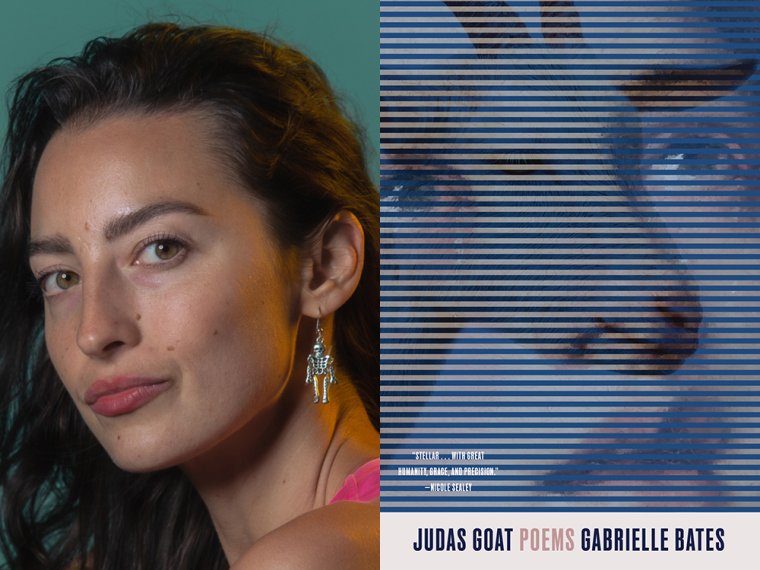This week’s installment of Ten Questions features Gabrielle Bates, whose poetry collection, Judas Goat, is out today from Tin House. In this sharp-eyed debut, Bates witnesses the coexistence of beauty and violence among family, friends, romantic partners, and the landscapes they inhabit. Opening on a disturbing memory about a dog who becomes trapped outside a moving subway car with his leash stuck between the automatic doors, Judas Goat imagines animals as both victims of human cruelty and mirrors for our own suffering and pleasure. If the speaker of “Impermanent” is “a creature / most at home / replenishing my venom under a rock,” other speakers in the collection are committed to understanding the depths of interpersonal connection: “What does it mean to say I love you?” Bates writes in the poem “Mothers.” Vulture praises Judas Goat: “These poems are both generous and spare, full of unconventional portraits of longing—for safety, for love, for a motherhood one doesn’t truly desire. Bates is a wise, tender witness to the parts of ourselves we rarely expose.” Gabrielle Bates’s poetry has appeared in American Poetry Review, the New Yorker, Poetry, and other publications. A writer and visual artist, she is a cohost of the Poet Salon podcast.

Gabrielle Bates, author of Judas Goat. (Credit: Liesa Cole)
1. How long did it take you to write Judas Goat?
The earliest seedlings of the book took root in 2013, and I was making edits up until the last minute. So about ten years.
2. What was the most challenging thing about writing the book?
It’s impossible to write resonant, alive poems on demand, just by working really hard; they can’t be bullied or willed into existence. This was one of the most challenging and wonderful aspects of writing this book. I had to feel my way forward, wondering and wanting.
3. Where, when, and how often do you write?
Lately, during seasons when it’s possible, I like to write outside—by hand. I also enjoy writing at my desk in Seattle, which faces windows into a courtyard where hummingbirds and rabbits visit. In the early years of working on Judas Goat, I woke up early and wrote every single morning, always on my computer. But I’m not regimented like that anymore.
4. What are you reading right now?
I’m doing a mix of reading and rereading right now: Dara Barrois/Dixon’s Tolstoy Killed Anna Karenina (Wave Books, 2022), Shirley Hazzard’s The Transit of Venus (Penguin Classics, 2021), Etel Adnan’s Of Cities & Women (Letters to Fawwaz) (The Post-Apollo Press, 1993), and a flurry of theoretical texts about eros and images.
5. What was your strategy for organizing the poems in this collection?
Ultimately, I would call my method of organization “very prolonged and collaborative trial and error.” Friends helped me—slowly, over the years—inch my way toward the order that ultimately appears. My incredible editor at Tin House, Alyssa Ogi, offered invaluable insights in the final stages. It was such a relief when the order finally clicked! I tried so many different approaches and orders for this book, I can’t even begin to remember them all.
6. How did you arrive at the title Judas Goat for this collection?
The poem “Judas Goat” was among the earliest poems I drafted for the book, but I refused to consider this phrase for the book’s title for a long time. I worried it would put too much pressure on one poem to encapsulate the book. In other books, if there’s a title poem, it’s usually the longest poem in the book, or a series of poems, but mine is very short. In spring 2020, I shared my manuscript with the poet Kary Wayson, and she helped me see that Judas Goat was the title.
7. What is one thing that surprised you during the writing of Judas Goat?
Any time a poem compels me to risk vulnerability, divulge a frightening confession, or shiver, I’m surprised—and grateful, and scared. Judas Goat is a record, in some ways, of these kinds of surprises.
8. If you could go back in time and talk to the earlier you, before you started Judas Goat, what would you say?
I don’t think I would say anything, actually; I think I would invite her to speak, and I would listen.
9. What forms of work, other than writing, did you have to do to complete this book?
Going for long walks, runs, and bus rides while listening to Between the Covers and Commonplace conversations in my headphones. Hosting, bookselling, and generally helping out at a thousand different live poetry readings. Being actively awash in the astounding range of contemporary poetics through my work at Open Books: A Poem Emporium. Traveling, mentally and physically, between Seattle and Birmingham, Alabama. Meeting weekly with a small handful of poets whose work excites and challenges me. Following my whims down research rabbit holes. I can’t imagine Judas Goat without these things.
10. What’s the best piece of writing advice you’ve ever received?
“Risk clarity.” —Vievee Francis








